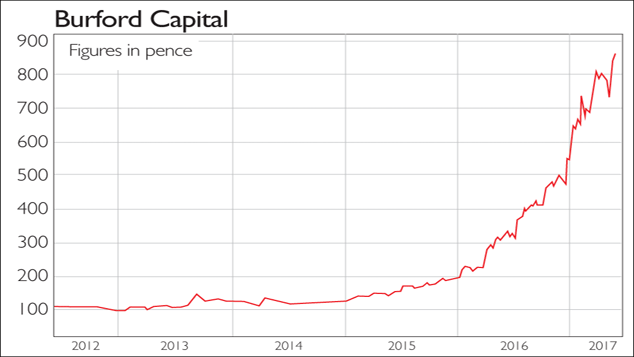A 5% yield from a solid issuer
Oliver Butt explains why a new retail bond from Burford Capital is an attractive opportunity.

Last week, the latest consumer price index (CPI) figures showed that inflation had jumped to a four-year high of 2.7% in April. Ten-year gilt yields responded by contracting a few basis points, from around 1.14% to 1.07%.Yield investors obviously do not live in a time of plenty, which means the new retail bond from Burford Capital offers an attractive opportunity. A 5% coupon is not easy to come by, the bond will trade on the London Stock Exchange's order book for retail bonds in denominations of £100, and it should be reasonably liquid.
No showmen need apply
Burford is an Aim-listed firm (see below) and is the world's largest provider of arbitration and litigation finance, meaning that it helps fund legal disputes. Do not feel queasy at the thought of crocodile-shoed lawyers gliding across the floor in pursuit of personal-injury claimants: Burford only provides finance for large corporations to sue other large corporations, or occasionally governments.
Both the litigants and Burford are dry calculators of odds and probabilities, not courtroom showmen. Litigation makes a positive return on average if it didn't, litigants wouldn't do it. Corporations also wouldn't use litigation finance if there wasn't a return after using it. And if the litigants using finance make money on average, so must the providers of finance. Burford aims to make superior returns to the average by cherry-picking cases.
MoneyWeek
Subscribe to MoneyWeek today and get your first six magazine issues absolutely FREE

Sign up to Money Morning
Don't miss the latest investment and personal finances news, market analysis, plus money-saving tips with our free twice-daily newsletter
Don't miss the latest investment and personal finances news, market analysis, plus money-saving tips with our free twice-daily newsletter
Burford operates internationally, generally in common-law jurisdictions, although the majority of the cases it funds are in the US. This is a large and growing market. The 100 biggest US law firms have annual revenues of $80bn, while 280,000 new federal claims are filed annually.
In addition, if the litigant funded their own claims then the costs of the case would come off the profit and loss account (for a non-principal activity), while any award or monies from a settlement would go below the line as an extraordinary item. This means that both accountancy treatment, as well the desire to lay off risk, is pushing firms to employ litigation finance.
Burford puts its own capital at risk in funding cases, but also receives fee income following the acquisition in 2016 of its biggest rival, GKC, an investment manager investing in claims (with $1.3bn in assets under management). Litigation investment income has been increasing strongly: from $36m (2014) to $88m (2015) and $140m (2016). New litigation investment commitments are up from $153m (2014) to $378m (2016).
A quality business
As a credit investor, it is important to look at the balance sheet. Prior to this £175m new bond issue, Burford had total debt of $230m backed by cash of $170m and assets (litigation investments) of $560m. That appears to be a good debt-to-equity ratio, but of course when you think of assets you normally imagine property, receivables, or plant and machinery. Burford's assets are an in tray of dry legal documents. How are these litigation assets valued? They are valued at cost ie, the money that has been spent on them. However, if there is a significant development for instance, a summary judgment then Burford's accountants insist the assets are revalued to reflect the new reality.
Burford would probably not get an investment-grade rating were it to apply for one, in part because a rating agency would struggle to value the assets. But it is a quality business and I like this bond. Both this and the previous two Burford bonds (which now yield 4.3% and 4.7%) are probably due a re-rating, since the lowest investment-grade bonds yield 2%-3% for a similar period.
A stellar share-price performance

Burford's shares have performed strongly in recent years. In October 2014, when it issued its first retail bond, the market cap was £244m. Today it is £1.81bn, with no rights issues along the way. Of course, bonds are credit and shares are equity, but this an encouraging pointer to its success.
| Issuer | Burford Capital PLC |
| Guarantor | Burford Capital Limited |
| Nominal amount | £175m |
| Rating | Unrated |
| Repayment | Bullet at par |
| Coupon | 5.0% semi-annual in arrears |
| Early redemption | Gilts + 100 bps |
| Coupon dates | 1 June, 1 December |
| First settlement date | 01-Jun-17 |
| Maturity date | 01-Dec-26 |
| ISIN number | XS1614096425 |
| Denominations | GBP100 |
| Listing | London Stock Exchange |
| Governing law | English law |
| Lead manager | Peel Hunt LLP |
Get the latest financial news, insights and expert analysis from our award-winning MoneyWeek team, to help you understand what really matters when it comes to your finances.
-
 How gifting money this Christmas could lower your inheritance tax bill
How gifting money this Christmas could lower your inheritance tax billCash is an easy and quick present to give over Christmas – and it could protect some of your estate from the taxman down the line
-
 £100 contactless card limit to be lifted
£100 contactless card limit to be liftedConsumers will be able to set their own contactless limits from March 2026, under new rules from the Financial Conduct Authority